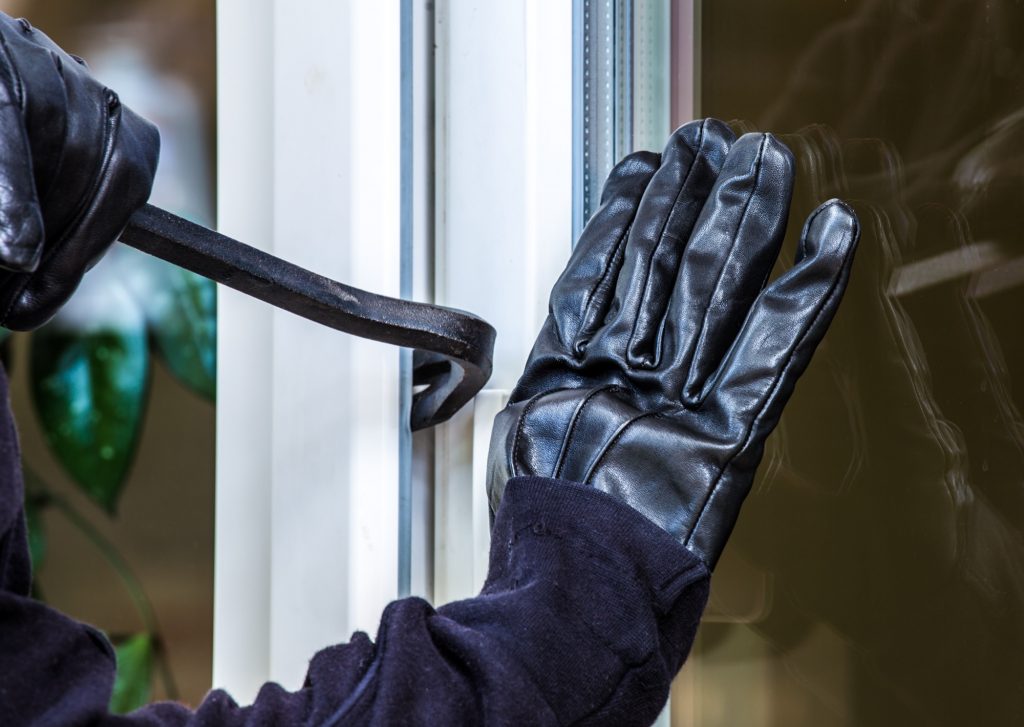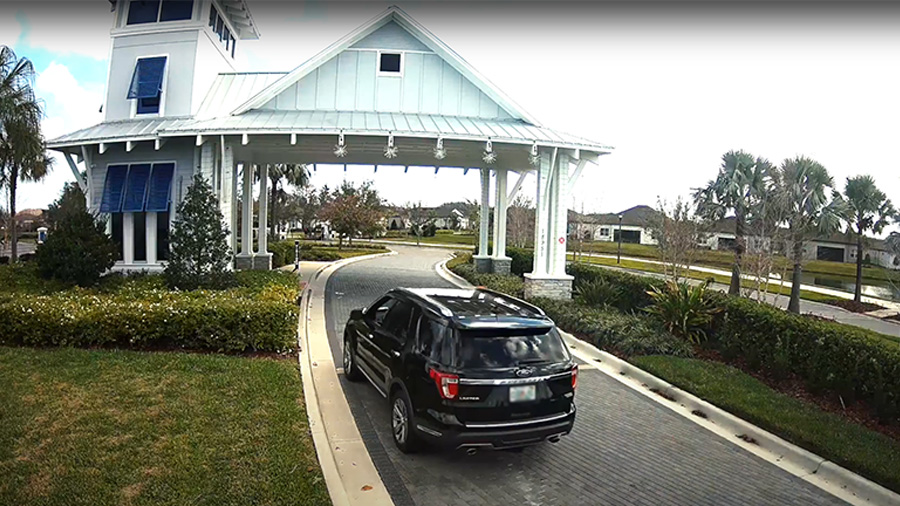Looking for up-to-date burglary statistics to gauge home safety in 2024? You’re in the right place. Residential burglary rates are seeing a notable decline, with a 3.8% drop just from the previous year. This piece delves into the pivotal factors influencing this trend and offers actionable advice to further bulletproof your home against break-ins.
Essential Burglary Statistics 2024: Understanding Trends for Safety and Prevention
Home burglary rates show a decline, with approximately 2.5 million occurrences annually leading to an estimated loss of $3.4 billion, and a significant drop in rates year-on-year, partially due to improved security systems and law enforcement efforts.
Burglars typically target front doors, first-floor windows, and back doors, with the bulk of break-ins occurring through these entry points, indicating the importance of robust security measures and the maintenance of locks and other deterrents.
Effective prevention strategies against burglary include the installation of security systems, varied locking mechanisms, clear visibility through landscaping, and active participation in neighborhood watch programs, which have been shown to reduce crime rates.
The Current State of Home Burglaries in 2024
In 2024, property crime continues to be a concern, but there’s a silver lining – a decline in home burglary rates. Every year, approximately 2.5 million burglaries occur, leading to an estimated loss of $3.4 billion in personal property. While these figures may seem alarming, home burglary statistics show a downward trend in residential burglary rates, with a noticeable 3.8% drop from the first half of 2022 to the first half of 2023.
Even cities once plagued with high burglary rates, like Chicago, have witnessed a significant decrease in burglaries, thanks to improved home security systems and vigilant law enforcement.
The decline in burglary rates
Burglary rates have been steadily declining for the past decade, with a noteworthy drop of 62% since 2012. This downward trend continued into the 2020s, with a 19% decrease witnessed between 2020 and 2021. But what’s behind this decline?

The answer lies in the combination of improved security systems and active law enforcement efforts. Property crime, particularly burglary, has been effectively countered by the adoption of advanced home security systems. These deterrents, along with efficient law enforcement and community vigilance, have managed to put a significant dent in property crimes, including burglary offenses.
Impact of COVID-19 on home burglaries
Despite our familiarity with the impacts of COVID-19, the pandemic presented an unexpected outcome. The enforcement of shelter-in-place policies led to a decrease in home burglaries. A nearly doubled decline of almost 19% was observed between 2020 and 2021, during the height of the pandemic.
This decrease can be attributed to the shift in work patterns. With more people working from home and fewer houses left unattended, burglars had fewer opportunities to strike. The pandemic inadvertently led most burglars to reconsider their plans, contributing significantly to the decline in the number of home invasions.
Common Entry Points for Burglars

Examining the burglars’ modus operandi reveals their preferred tactics. Front doors, first-floor windows, and back doors are their favored entry points, accounting for 34%, 23%, and 22% of all burglaries respectively. Often, burglars find it easy to break in through doors by exploiting hidden keys or simply walking through doors left unlocked. In some cases, an attempted forcible entry is made, highlighting the importance of securing your home against break-ins. It’s worth noting that a significant number of burglaries involved forcible entry, emphasizing the need for robust security measures to prevent a burglars break and protect against any potential unlawful entry.
First-floor windows present an easy target too, especially when left unlocked or when the glass can be easily broken. Garages, basements, and sheds also pose risks, presenting opportunities for 6% of burglars.
Front door vulnerabilities
It’s worth noting, front doors often serve as a primary target for burglars, with about 34% of burglars using this as their point of entry. This vulnerability arises from the ease of access and often the lack of robust security measures. However, homeowners are increasingly adopting stringent measures to secure their front doors.
The glass used in front doors is designed to be six times tougher to break compared to typical window glass, reducing the likelihood of forced entry. The adoption of privacy glass options, like rain or frosted glass, can obscure visibility into the home while maintaining aesthetic appeal. Additionally, installing double-keyed deadbolts on glass doors that are within arm’s reach of the lock can prevent burglars from unlocking the door even if they manage to break the glass.
Back door and window risks

While front doors are a common target, back doors and windows aren’t far behind. About 22% of burglars gain access to homes through the back door, making it a significant risk point in home security. It’s worth noting that the risk escalates during the summer months when people are more likely to leave these entry points open or unlocked.
Therefore, it’s crucial to keep back doors and windows secured, even during the day. And while enjoying the summer breeze, remember to lock up before leaving your home unattended. After all, most burglars don’t need to break in if they can just walk in through an unlocked back door or window.
Most Frequently Stolen Items in Home Burglaries
It’s valuable to understand what burglars typically target. Here are some common items:
- Small, valuable items such as wallets, cash, and jewelry
- Electronics like TVs, cell phones, and computers
- Smaller pieces of furniture
- Bicycles
These items are often targeted due to their small size, high resale value, popularity, and ease of transport.
And if you’re wondering where burglars are most likely to look for these items, the master bedroom is often their first stop.
Timeframes and Patterns in Home Burglaries
The timing of when burglars strike is as important as understanding what they steal. Most home break-ins occur during the day, with peak times between 10:00am and 3:00pm. Fridays have been identified as the weekday with the highest likelihood of burglary occurrences.
Furthermore, the month of November experiences the highest number of home burglaries. This underlines the importance of being extra vigilant during these times and taking steps to deter burglars.
Daytime vs. nighttime break-ins
Contrary to popular belief, most home break-ins occur during daylight hours. There were more burglaries during the day, with 239,137 occurrences, compared to 184,846 at night. The peak hours for daytime burglaries are between 10 a.m. and 3 p.m. But why is this the case?
The answer is surprisingly simple – most homes are unoccupied during the day. With adults at work and children at school, homes are often left empty, making them an easier target for burglars. This underlines the importance of having a reliable home security system that works effectively, even when you’re not home.
Seasonal trends in burglary rates
Seasons also play a role in burglary trends. Here is a breakdown of burglary rates by season:
- Summer: experiences the most burglaries compared to other seasons
- Winter: burglaries decrease by 11% compared to summer rates
- Spring: burglaries decrease by 9% compared to summer rates and has the lowest occurrence of burglaries throughout the year
- Fall: burglaries decrease by 6% compared to summer rates
This seasonal trend can be attributed to the fact that people tend to travel more during the summer, leaving their homes unattended. On the other hand, in the winter and spring, people are more likely to stay home due to the colder weather and school being in session. This underscores the importance of arranging for home security measures, especially when planning to be away for extended periods.
For security systems for your school click here
How to Deter Burglars: Effective Prevention Strategies

Alongside understanding burglary trends, knowing how to deter burglars is of paramount importance. Effective prevention strategies include:
- Installing security systems
- Using multiple types of locks
- Maintaining clear visibility through landscaping
- Install community gates with Virtual Gate Guards
- Participating in neighborhood watch programs
Even simple measures like leaving a car in the driveway or keeping a battery-powered radio on can give an impression of occupancy, hence deterring potential burglars.
Locks and alarms
A robust locking system combined with an alarm system forms the first line of defense against burglars. Doorknob locks offer minimal security and can be easily bypassed by burglars, which is why pairing them with additional locks, such as deadbolts, is essential for effective protection. However, even deadbolts can be compromised if a burglar breaks a door-side window or forcefully breaks the doorframe.
Keypad locks add the convenience of code entry but share the same vulnerabilities as doorknob locks and should be augmented with other locking mechanisms. Bars, bolts, and chains can serve as additional physical barriers to doors but are not foolproof and are best used in combination with other more secure locks.
The most effective locks for preventing home burglaries include deadbolts, smart locks, and locks with anti-snap cylinders. Utilizing a combination of different lock types, potentially together with a monitored home security system, can provide the highest level of protection against burglaries.
Landscaping and lighting
While locks and alarms form the first line of defense, proper landscaping and lighting can further enhance your home’s security. Maintaining a clear line of sight to the front door from the street through appropriate landscaping can deter potential burglars. Keeping shrubs and trees well-trimmed around entry points enhances visibility and prevents burglars from using overgrown vegetation as hiding spots.
Additionally, strategic placement of landscape lighting can complicate an intruder’s approach, making it difficult to approach a home unnoticed and acting as a burglary deterrent. In fact, about 60 percent of burglars admit that exterior lighting, indicative of a security system presence, persuades them to bypass a home.
Neighborhood watch programs
Last but not least, neighborhood watch programs add an extra layer of security by promoting vigilance among residents and improving communication with law enforcement. These programs can:
- Reduce crime rates by up to 16%
- The United States has approximately 25,000 registered Neighborhood Watch programs
- Studies have shown that these programs can significantly decrease property crime.
Participation in these programs not only improves safety but also fosters community bonds. In fact, a study published in 2014 indicated that Neighborhood Watch programs can improve residents’ sense of safety by 93%. So, if your neighborhood doesn’t have a watch program yet, starting one could be a great way to enhance community safety and cohesion.
Burglary Statistics by State and City
Burglary statistics also vary from one region to another, reflecting the diverse socioeconomic and demographic realities across different states and cities. For instance, in 2021, New Mexico had the highest burglary rate per 100,000 people among U.S. states. Meanwhile, among the 10 most populous cities, Houston saw the highest number of burglaries in 2021.
On the other end of the spectrum, New York City boasts the fewest burglaries per capita among the most populous U.S. cities.
Top states for home burglaries
When focusing on the state-level data, the following states stand out for their high burglary rates:
- New Mexico
- Arkansas
- Louisiana
- South Carolina
In fact, Arkansas recorded a specific burglary rate of 523 per 100,000 people, and Louisiana had a burglary rate of 510 per 100,000 residents.
However, not all states experience high burglary rates. In fact, some states have very low burglary rates. Here are a few examples:
- New Hampshire and Puerto Rico had the lowest burglary rates in 2021.
- New Hampshire had the lowest rate per 100,000 residents.
- Virginia had the second-lowest burglary rate in 2024.
Safest cities from burglaries
Moving from states to cities, it’s interesting to note that some of the most populous cities in the U.S. have managed to keep their burglary rates low. New York City, for instance, stands out as the most populous city with the fewest burglaries per capita in 2022. San Diego also reported a low crime rate, with 235 offenses per 100,000 residents in 2022. This places it among the cities with comparatively low crime rates.
The low burglary rates in these cities underscore the effectiveness of their safety and prevention measures against burglaries. They serve as prime examples of how law enforcement agencies, community participation, and effective city planning can work together to create safer environments for residents.
Demographics and Profiles of Burglars

Understanding the typical demographic and profile of burglars can provide valuable insights into their motivations and methods. The most common demographic involves males under the age of 25, specifically between 18-24 years old. Moreover, in a significant number of burglaries, approximately 30 percent, the victim knew the burglar. This goes to show that burglars can often look like ordinary people and may blend into their surroundings, making them not easily identifiable based on appearance alone.
Age and gender distribution
When it comes to age and gender distribution among burglars, males, particularly those falling within the age range of 18 to 24 years, dominate the demographic. Gender distribution in burglary statistics skews heavily towards males, particularly in this youthful age segment.
This young male demographic is often associated with high-risk behavior and susceptibility to peer pressure, factors that could potentially explain their overrepresentation in burglary offenses. Understanding the age distribution of burglars is crucial in developing targeted prevention strategies.
Criminal backgrounds
Burglars often have a history of prior arrests, marking them as repeat offenders. These individuals usually plan a burglary within 24 hours of committing the act, indicating a degree of impulsiveness and opportunistic behavior. It’s also worth noting that high poverty rates, like the 15.6% in Oklahoma, are likely contributing factors to higher burglary rates, which is when burglaries happen. Unfortunately, this leads to an increased number of burglary victims in such areas.
In contrast, states with lower poverty rates, such as New Hampshire’s 7.2%, can correspond to lower rates of burglary. This suggests that socioeconomic factors can significantly influence burglary rates, underscoring the importance of broader societal interventions in crime prevention.
The Impact of Home Burglaries on Insurance Rates
Home burglaries not only lead to a loss of personal property but can also have a significant impact on a homeowner’s insurance rates. Homeowners insurance offers reimbursement for stolen property and repairs for damaged home structure, typically with a policy limit and deductible. However, filing a burglary claim may result in increased insurance premiums for the homeowner.
Therefore, to ensure adequate coverage in case of a burglary, it’s crucial for homeowners or renters to carefully choose an insurance plan that meets their needs.
Filing a claim after a burglary
In case of a burglary, knowing how to file an insurance claim is essential. Here are the steps to follow:
- Document everything at the scene of the burglary, including taking photos of damage and listing stolen or damaged items.
- Contact the insurance company promptly.
- Gather information on the claims process, including finding out the timeframe for filing and what documents are needed.
Filing an insurance claim through various methods such as:
- Online
- Mobile app
- Phone
- Sending a completed claims form via email or fax
It’s important to remember that each insurance company may have a different process, so it’s crucial to understand your insurer’s specific procedures.
Insurance rate increases
While filing a burglary claim may help to recover some of the losses incurred, it may also lead to increased insurance premiums. This is because insurance companies consider past claims when setting premium rates, viewing homes with previous burglary claims as more likely to have future claims.
While reporting a burglary to your insurance company and filing a claim is vital, understanding the prospective impact on future insurance rates is equally significant. Investing in preventative measures to decrease the likelihood of a burglary, from installing a robust home security system to becoming involved in neighborhood watch programs, could potentially help keep your insurance premiums lower in the long run.
Summary
In conclusion, understanding the dynamics of home burglaries, from the current rates to the profile of a typical burglar, is crucial for effective prevention. By being aware of common entry points and frequently stolen items, one can take targeted measures to secure their homes. Moreover, the selection of an appropriate insurance plan can provide financial protection in case of a burglary. The fight against burglary is multifaceted, involving not just individual homeowners, but also communities, law enforcement, and societal interventions.
Frequently Asked Questions
What times of the day are home burglaries most likely to occur?
Home burglaries are most likely to occur during the day, with peak times between 10:00am and 3:00pm. Be vigilant during these hours to increase security.
What are the most common entry points for burglars?
The most common entry points for burglars are front doors, first-floor windows, and back doors. These areas should be prioritized for security measures.
What items are most commonly stolen in burglaries?
During burglaries, small, valuable items like wallets, cash, and jewelry are commonly stolen, along with electronics such as TVs, cell phones, and computers. It’s important to store these items securely.
How can I deter burglars from targeting my home?
To deter burglars from targeting your home, consider installing security systems, using multiple types of locks, maintaining clear visibility through landscaping, and participating in neighborhood watch programs. These steps can help safeguard your home and make it a less appealing target for burglars.
How does a burglary affect my insurance rates?
Filing a burglary claim may lead to increased insurance premiums for the homeowner. Prepare for potential rate changes if you file a claim for burglary.






